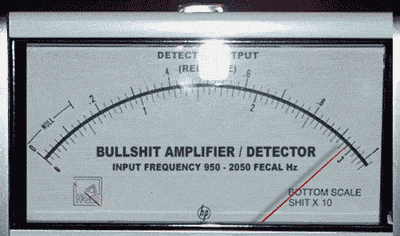Required: One BS Detector
Posted in: Uncategorized The rapid changes in technology, advertising, and social media have brought along their baggage: jargon, political-correctness, new terminology, “cutesy” names, and phrases that just are not understandable. At least once a week I find it necessary to search for meaning on “new” words. When I spell-check posts or documents, many of the words that I read, or even use, on a regular basis show up with the red squiggle…misspelled. The real fact is that they did not exist when Office 2007 debuted, so the handy-dandy dictionary doesn’t recognize them. Thus, my custom dictionary is growing. Now I have to worry about the fact that if I misspell a simple word, such as bitter, I may end up with bit.ly. Thus, read and re-read everything you write.
The rapid changes in technology, advertising, and social media have brought along their baggage: jargon, political-correctness, new terminology, “cutesy” names, and phrases that just are not understandable. At least once a week I find it necessary to search for meaning on “new” words. When I spell-check posts or documents, many of the words that I read, or even use, on a regular basis show up with the red squiggle…misspelled. The real fact is that they did not exist when Office 2007 debuted, so the handy-dandy dictionary doesn’t recognize them. Thus, my custom dictionary is growing. Now I have to worry about the fact that if I misspell a simple word, such as bitter, I may end up with bit.ly. Thus, read and re-read everything you write.
Along with these new words, we seem to be using more words to say less, working in keywords along with key points into our blogs, press releases, and online articles. Companies, wanting to look smarter, are actually failing to get their point across due the amount of BS they incorporate with their corporate communications.
 And that’s why I use HubSpot’s BS detector, or, as they call it, the Gobbledygook Grader, which grades exactly what you think it does: crap.
And that’s why I use HubSpot’s BS detector, or, as they call it, the Gobbledygook Grader, which grades exactly what you think it does: crap.
The site is very simple to use:
- Enter copy into copy block area on Grader site
- Enter your email address
- Hit the “Grade Content” button
What comes out can be quite disappointing, especially if you think that you’ve written a masterpiece and find out it’s a turd. It’s not a perfect measurement tool, but it does provide a list of the Gobbledygook words, a word cloud so that you can see how many times you’ve overused certain words, as well as a word-counter, sentence counter, and the minimum education necessary to read the document. (Although mainly a PR tool, it’s become rather useful for cover letters, blog posts, and articles.) Realize that if you are grading something other than a brochure or press release, the calculations don’t work out perfectly and the score will be low. However, I use it as a proofing device, so it’s not the score, but what it displays about my writing, or over-writing.

The top ten “worst of the worst” words are, from most-offensive to least: lead generation, robust, flexible, world class, easy to use, scalable, cutting edge, well positioned, market leading, and mission critical. If you’re using these words in your writing endeavors, please stop now.
HubSpot also offers graders for Facebook, Twitter, Blogs, Social Personalities, Press Releases, and Web Sites, so it’s simple to gauge where you, or your company, “rank” in the Social Media sphere. To access all of the graders at once, go to HubSpot’s website and click on the Grader link.
As the online space expands, rest assured that the cutting-edge, scalable, mission-critical buzzwords will become a robust and break-through method of delivering market-leading information in a user-friendly method.
(Authors Note: none of the 18 Gobbledygook words included in this post were harmed during writing.)
Jeff Louis: Strategic Media Planner, Brand Project Manager, blogger and aspiring writer. To contact Jeff, leave a comment or find him on www.linkedin.com or www.twitter.com.

